brake SAAB 9-3 2009 Owners Manual
[x] Cancel search | Manufacturer: SAAB, Model Year: 2009, Model line: 9-3, Model: SAAB 9-3 2009Pages: 304, PDF Size: 44.31 MB
Page 4 of 304
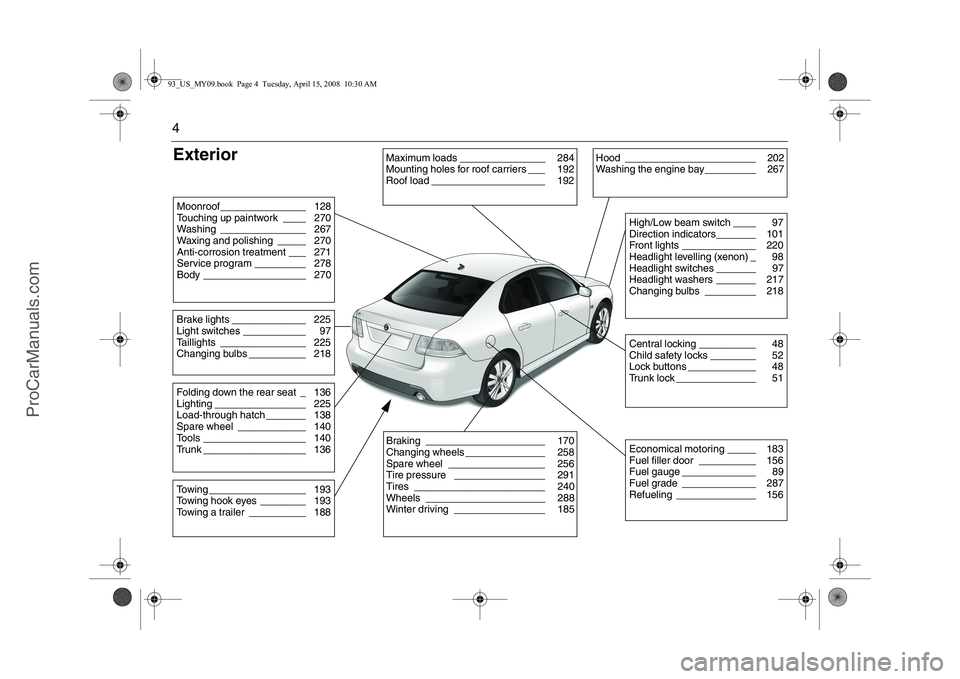
4ExteriorMoonroof_______________ 128
Touching up paintwork ____ 270
Washing _______________ 267
Waxing and polishing _____ 270
Anti-corrosion treatment ___ 271
Service program _________ 278
Body __________________ 270Brake lights _____________ 225
Light switches ___________ 97
Taillights _______________ 225
Changing bulbs __________ 218Towing _________________ 193
Towing hook eyes ________ 193
Towing a trailer __________ 188Folding down the rear seat _ 136
Lighting ________________ 225
Load-through hatch _______ 138
Spare wheel ____________ 140
Tools __________________ 140
Trunk __________________ 136
Maximum loads _______________ 284
Mounting holes for roof carriers ___ 192
Roof load ____________________ 192
Hood _______________________ 202
Washing the engine bay_________ 267
Central locking __________ 48
Child safety locks ________ 52
Lock buttons ____________ 48
Trunk lock ______________ 51High/Low beam switch ____ 97
Direction indicators_______ 101
Front lights _____________ 220
Headlight levelling (xenon) _ 98
Headlight switches _______ 97
Headlight washers _______ 217
Changing bulbs _________ 218Economical motoring _____ 183
Fuel filler door __________ 156
Fuel gauge _____________ 89
Fuel grade _____________ 287
Refueling ______________ 156
Braking _____________________ 170
Changing wheels ______________ 258
Spare wheel _________________ 256
Tire pressure ________________ 291
Tires _______________________ 240
Wheels _____________________ 288
Winter driving ________________ 185
93_US_MY09.book Page 4 Tuesday, April 15, 2008 10:30 AM
ProCarManuals.com
Page 5 of 304
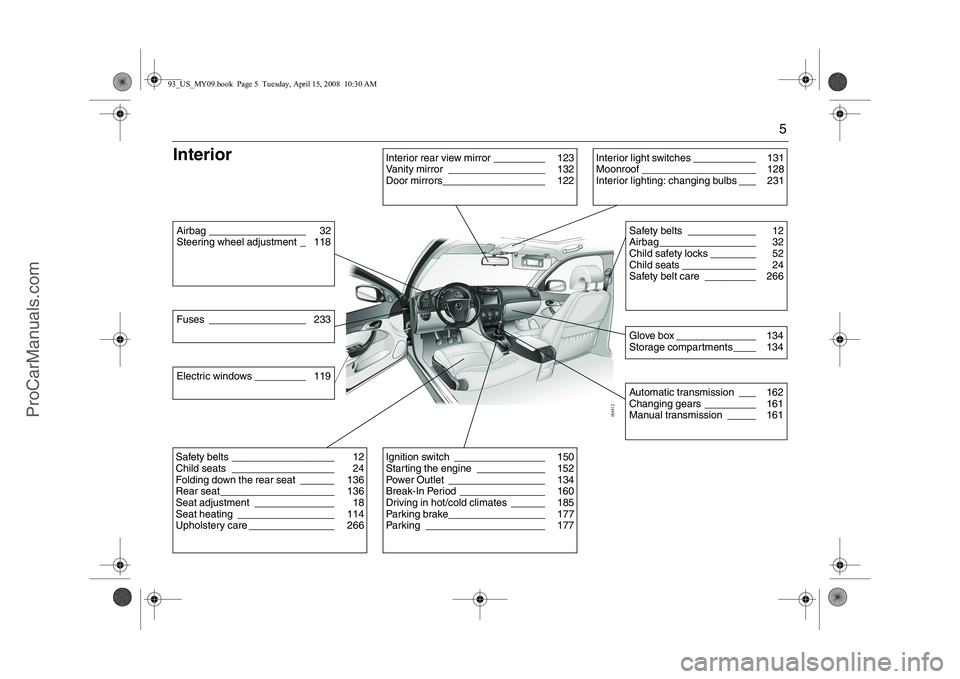
5
InteriorAirbag _________________ 32
Steering wheel adjustment _ 118
Interior rear view mirror _________ 123
Vanity mirror _________________ 132
Door mirrors__________________ 122
Safety belts ____________ 12
Airbag_________________ 32
Child safety locks ________ 52
Child seats _____________ 24
Safety belt care _________ 266Glove box ______________ 134
Storage compartments ____ 134Automatic transmission ___ 162
Changing gears _________ 161
Manual transmission _____ 161
Safety belts __________________ 12
Child seats __________________ 24
Folding down the rear seat ______ 136
Rear seat ____________________ 136
Seat adjustment ______________ 18
Seat heating _________________ 114
Upholstery care _______________ 266
Interior light switches ___________ 131
Moonroof ____________________ 128
Interior lighting: changing bulbs ___ 231
Ignition switch ________________ 150
Starting the engine ____________ 152
Power Outlet _________________ 134
Break-In Period _______________ 160
Driving in hot/cold climates ______ 185
Parking brake_________________ 177
Parking _____________________ 177
Fuses _________________ 233Electric windows _________ 11993_US_MY09.book Page 5 Tuesday, April 15, 2008 10:30 AM
ProCarManuals.com
Page 6 of 304
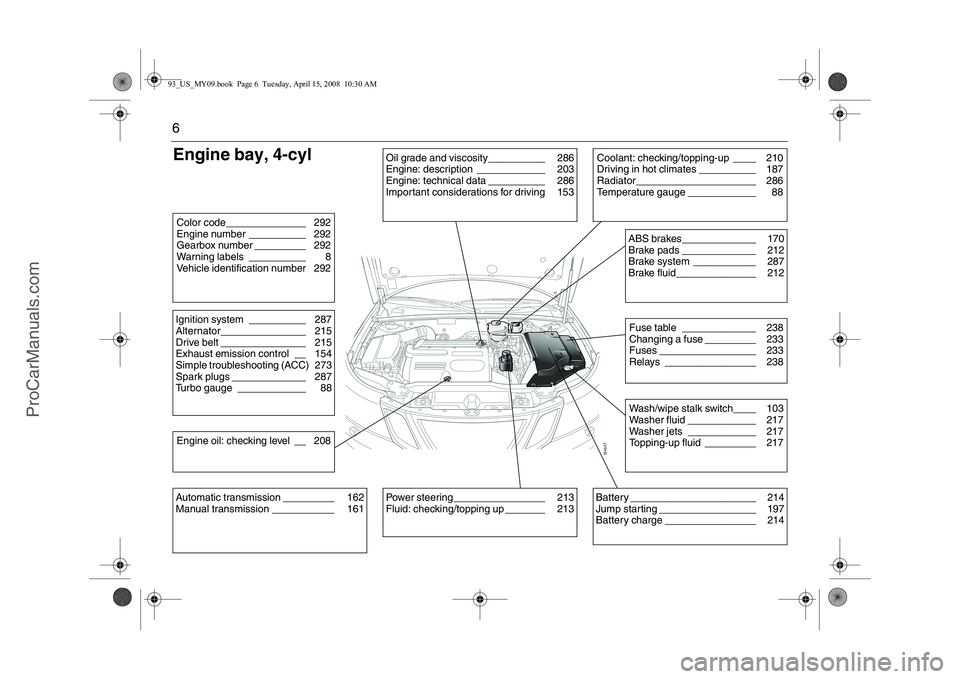
6Engine bay, 4-cylColor code______________ 292
Engine number __________ 292
Gearbox number _________ 292
Warning labels __________ 8
Vehicle identification number 292Ignition system __________ 287
Alternator_______________ 215
Drive belt _______________ 215
Exhaust emission control __ 154
Simple troubleshooting (ACC) 273
Spark plugs _____________ 287
Turbo gauge ____________ 88Engine oil: checking level __ 208Automatic transmission _________ 162
Manual transmission ___________ 161
Battery ______________________ 214
Jump starting _________________ 197
Battery charge ________________ 214
Oil grade and viscosity__________ 286
Engine: description ____________ 203
Engine: technical data __________ 286
Important considerations for driving 153
Wash/wipe stalk switch____ 103
Washer fluid ____________ 217
Washer jets ____________ 217
Topping-up fluid _________ 217
Power steering ________________ 213
Fluid: checking/topping up _______ 213
Coolant: checking/topping-up ____ 210
Driving in hot climates __________ 187
Radiator _____________________ 286
Temperature gauge ____________ 88
Fuse table _____________ 238
Changing a fuse _________ 233
Fuses _________________ 233
Relays ________________ 238ABS brakes_____________ 170
Brake pads _____________ 212
Brake system ___________ 287
Brake fluid______________ 212
93_US_MY09.book Page 6 Tuesday, April 15, 2008 10:30 AM
ProCarManuals.com
Page 7 of 304
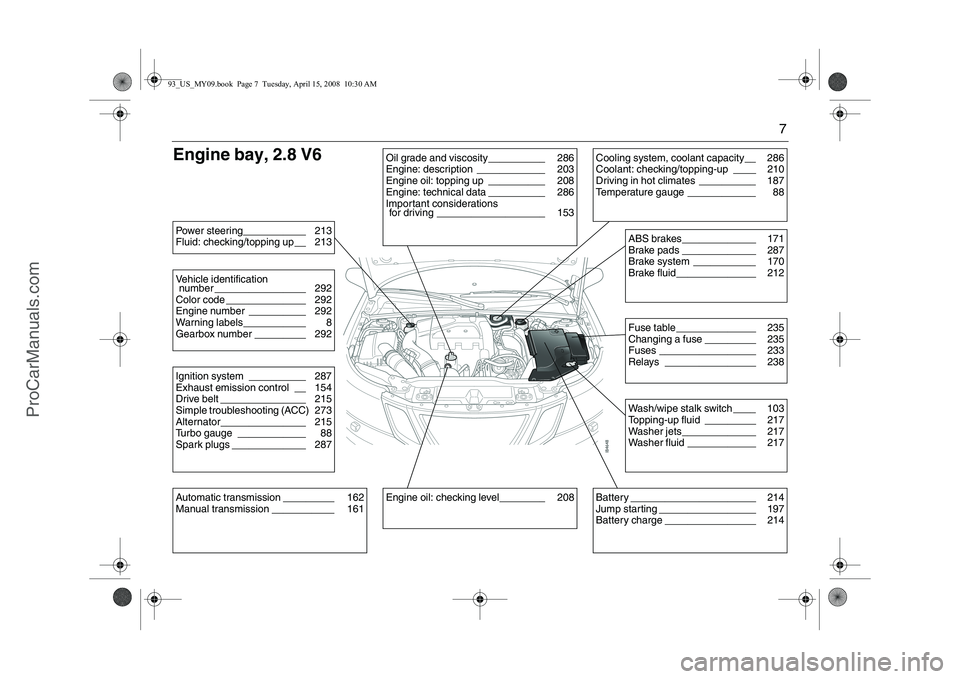
7
Engine bay, 2.8 V6Power steering___________ 213
Fluid: checking/topping up__ 213Vehicle identification
number ________________ 292
Color code ______________ 292
Engine number __________ 292
Warning labels___________ 8
Gearbox number _________ 292Ignition system __________ 287
Exhaust emission control __ 154
Drive belt _______________ 215
Simple troubleshooting (ACC) 273
Alternator_______________ 215
Turbo gauge ____________ 88
Spark plugs _____________ 287Automatic transmission _________ 162
Manual transmission ___________ 161
Oil grade and viscosity__________ 286
Engine: description ____________ 203
Engine oil: topping up __________ 208
Engine: technical data __________ 286
Important considerations
for driving ___________________ 153Engine oil: checking level________ 208
Battery ______________________ 214
Jump starting _________________ 197
Battery charge ________________ 214
Wash/wipe stalk switch ____ 103
Topping-up fluid _________ 217
Washer jets_____________ 217
Washer fluid ____________ 217Fuse table ______________ 235
Changing a fuse _________ 235
Fuses _________________ 233
Relays ________________ 238ABS brakes_____________ 171
Brake pads _____________ 287
Brake system ___________ 170
Brake fluid______________ 212
Cooling system, coolant capacity__ 286
Coolant: checking/topping-up ____ 210
Driving in hot climates __________ 187
Temperature gauge ____________ 88
93_US_MY09.book Page 7 Tuesday, April 15, 2008 10:30 AM
ProCarManuals.com
Page 10 of 304
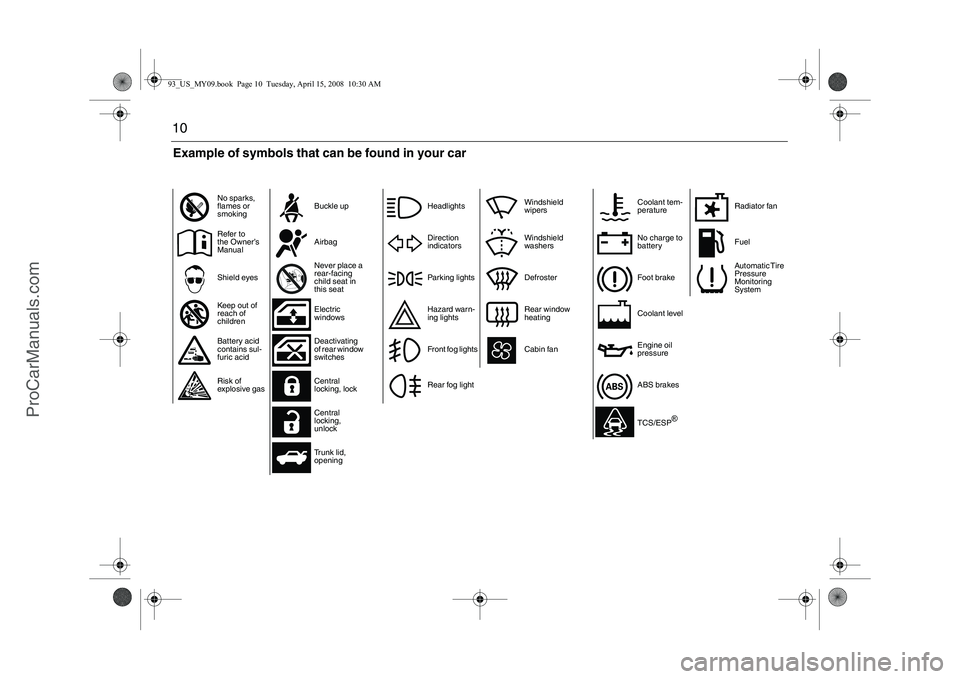
10
No sparks,
flames or
smokingBuckle up
Refer to
the Owner’s
ManualAirbag
Shield eyesNever place a
rear-facing
child seat in
this seat
Keep out of
reach of
childrenElectric
windows
Battery acid
contains sul-
furic acidDeactivating
of rear window
switches
Risk of
explosive gasCentral
locking, lock
Central
locking,
unlock
Trunk lid,
opening
HeadlightsWindshield
wipers
Direction
indicatorsWindshield
washers
Parking lights Defroster
Hazard warn-
ing lightsRear window
heating
Front fog lights Cabin fan
Rear fog light
Coolant tem-
peratureRadiator fan
No charge to
batteryFuel
Foot brakeAutomatic Tire
Pressure
Monitoring
System
Coolant level
Engine oil
pressure
ABS brakes
TCS/ESP
®
Example of symbols that can be found in your car93_US_MY09.book Page 10 Tuesday, April 15, 2008 10:30 AM
ProCarManuals.com
Page 13 of 304
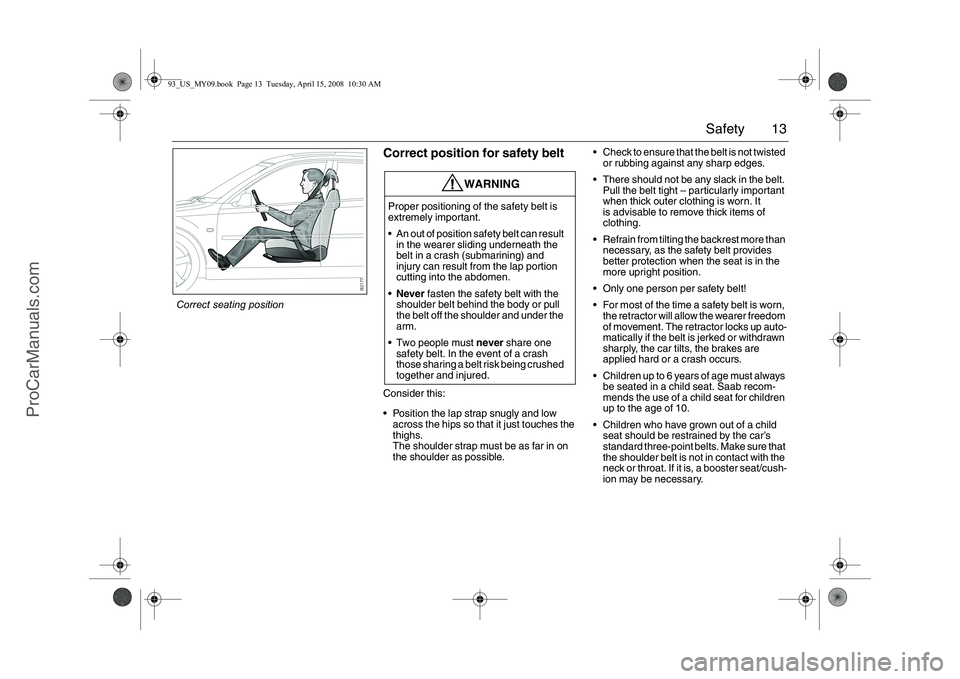
13 Safety
Correct position for safety beltConsider this:
Position the lap strap snugly and low
across the hips so that it just touches the
thighs.
The shoulder strap must be as far in on
the shoulder as possible. Check to ensure that the belt is not twisted
or rubbing against any sharp edges.
There should not be any slack in the belt.
Pull the belt tight – particularly important
when thick outer clothing is worn. It
is advisable to remove thick items of
clothing.
Refrain from tilting the backrest more than
necessary, as the safety belt provides
better protection when the seat is in the
more upright position.
Only one person per safety belt!
For most of the time a safety belt is worn,
the retractor will allow the wearer freedom
of movement. The retractor locks up auto-
matically if the belt is jerked or withdrawn
sharply, the car tilts, the brakes are
applied hard or a crash occurs.
Children up to 6 years of age must always
be seated in a child seat. Saab recom-
mends the use of a child seat for children
up to the age of 10.
Children who have grown out of a child
seat should be restrained by the car’s
standard three-point belts. Make sure that
the shoulder belt is not in contact with the
neck or throat. If it is, a booster seat/cush-
ion may be necessary.
WARNING
Proper positioning of the safety belt is
extremely important.
An out of position safety belt can result
in the wearer sliding underneath the
belt in a crash (submarining) and
injury can result from the lap portion
cutting into the abdomen.
Never fasten the safety belt with the
shoulder belt behind the body or pull
the belt off the shoulder and under the
arm.
Two people must never share one
safety belt. In the event of a crash
those sharing a belt risk being crushed
together and injured.
Correct seating position93_US_MY09.book Page 13 Tuesday, April 15, 2008 10:30 AM
ProCarManuals.com
Page 82 of 304
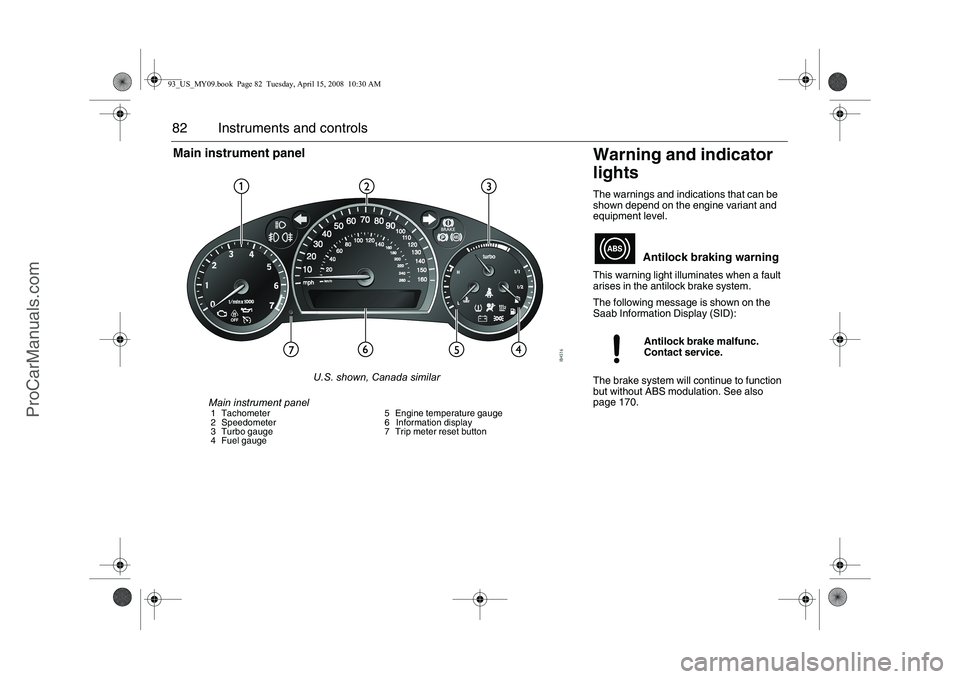
82 Instruments and controls
Warning and indicator
lightsThe warnings and indications that can be
shown depend on the engine variant and
equipment level.
This warning light illuminates when a fault
arises in the antilock brake system.
The following message is shown on the
Saab Information Display (SID):
The brake system will continue to function
but without ABS modulation. See also
page 170.
Antilock braking warningAntilock brake malfunc.
Contact service.
Main instrument panel1 Tachometer
2 Speedometer
3 Turbo gauge
4 Fuel gauge5 Engine temperature gauge
6 Information display
7 Trip meter reset button
Main instrument panel
U.S. shown, Canada similar
93_US_MY09.book Page 82 Tuesday, April 15, 2008 10:30 AM
ProCarManuals.com
Page 83 of 304
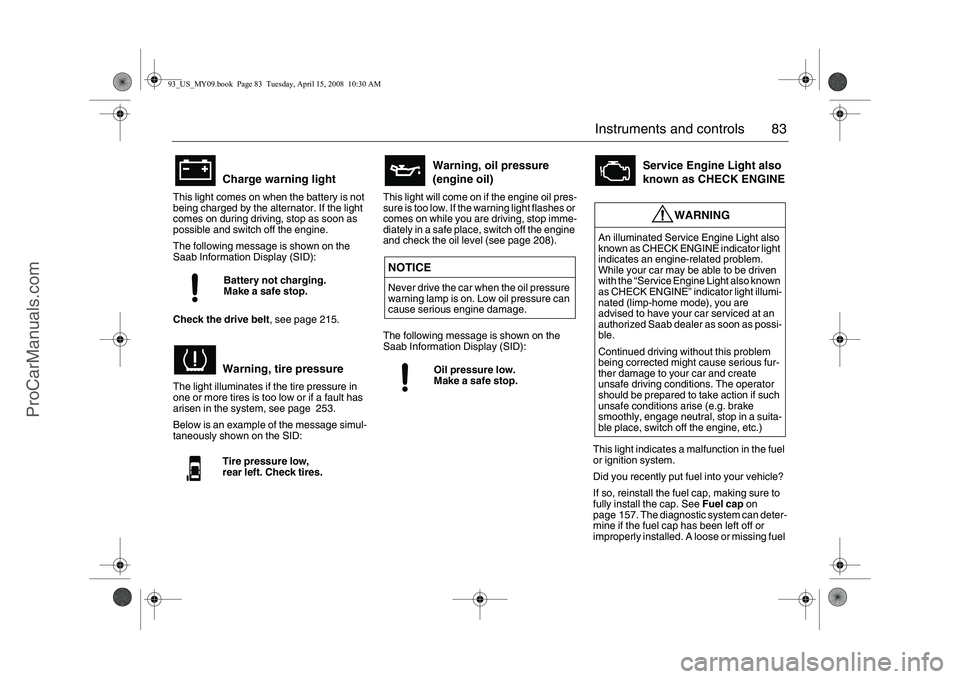
83 Instruments and controls
This light comes on when the battery is not
being charged by the alternator. If the light
comes on during driving, stop as soon as
possible and switch off the engine.
The following message is shown on the
Saab Information Display (SID):
Check the drive belt, see page 215.
The light illuminates if the tire pressure in
one or more tires is too low or if a fault has
arisen in the system, see page 253.
Below is an example of the message simul-
taneously shown on the SID:This light will come on if the engine oil pres-
sure is too low. If the warning light flashes or
comes on while you are driving, stop imme-
diately in a safe place, switch off the engine
and check the oil level (see page 208).
The following message is shown on the
Saab Information Display (SID):
This light indicates a malfunction in the fuel
or ignition system.
Did you recently put fuel into your vehicle?
If so, reinstall the fuel cap, making sure to
fully install the cap. See Fuel cap on
page 157. The diagnostic system can deter-
mine if the fuel cap has been left off or
improperly installed. A loose or missing fuel
Charge warning lightBattery not charging.
Make a safe stop.Warning, tire pressureTire pressure low,
rear left. Check tires.
Warning, oil pressure
(engine oil)
NOTICE
Never drive the car when the oil pressure
warning lamp is on. Low oil pressure can
cause serious engine damage.
Oil pressure low.
Make a safe stop.
Service Engine Light also
known as CHECK ENGINE
WARNING
An illuminated Service Engine Light also
known as CHECK ENGINE indicator light
indicates an engine-related problem.
While your car may be able to be driven
with the “Service Engine Light also known
as CHECK ENGINE” indicator light illumi-
nated (limp-home mode), you are
advised to have your car serviced at an
authorized Saab dealer as soon as possi-
ble.
Continued driving without this problem
being corrected might cause serious fur-
ther damage to your car and create
unsafe driving conditions. The operator
should be prepared to take action if such
unsafe conditions arise (e.g. brake
smoothly, engage neutral, stop in a suita-
ble place, switch off the engine, etc.)
93_US_MY09.book Page 83 Tuesday, April 15, 2008 10:30 AM
ProCarManuals.com
Page 84 of 304
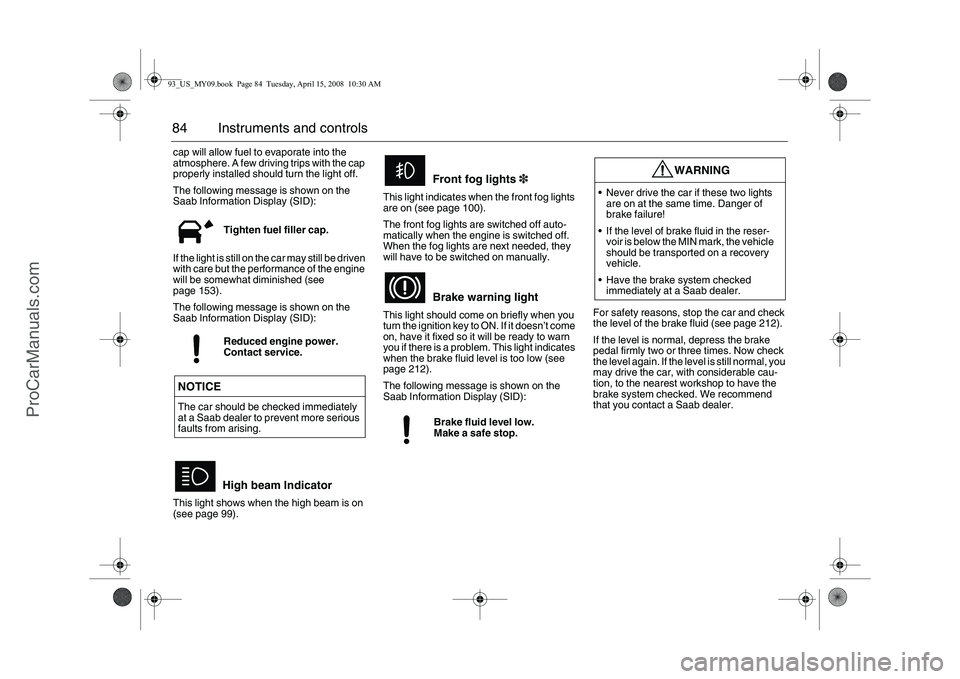
84 Instruments and controlscap will allow fuel to evaporate into the
atmosphere. A few driving trips with the cap
properly installed should turn the light off.
The following message is shown on the
Saab Information Display (SID):
If the light is still on the car may still be driven
with care but the performance of the engine
will be somewhat diminished (see
page 153).
The following message is shown on the
Saab Information Display (SID):
This light shows when the high beam is on
(see page 99).This light indicates when the front fog lights
are on (see page 100).
The front fog lights are switched off auto-
matically when the engine is switched off.
When the fog lights are next needed, they
will have to be switched on manually.
This light should come on briefly when you
turn the ignition key to ON. If it doesn’t come
on, have it fixed so it will be ready to warn
you if there is a problem. This light indicates
when the brake fluid level is too low (see
page 212).
The following message is shown on the
Saab Information Display (SID):For safety reasons, stop the car and check
the level of the brake fluid (see page 212).
If the level is normal, depress the brake
pedal firmly two or three times. Now check
the level again. If the level is still normal, you
may drive the car, with considerable cau-
tion, to the nearest workshop to have the
brake system checked. We recommend
that you contact a Saab dealer. Tighten fuel filler cap.
Reduced engine power.
Contact service.NOTICEThe car should be checked immediately
at a Saab dealer to prevent more serious
faults from arising.
High beam Indicator
Front fog lights3
Brake warning lightBrake fluid level low.
Make a safe stop.
WARNING
Never drive the car if these two lights
are on at the same time. Danger of
brake failure!
If the level of brake fluid in the reser-
voir is below the MIN mark, the vehicle
should be transported on a recovery
vehicle.
Have the brake system checked
immediately at a Saab dealer.
93_US_MY09.book Page 84 Tuesday, April 15, 2008 10:30 AM
ProCarManuals.com
Page 85 of 304
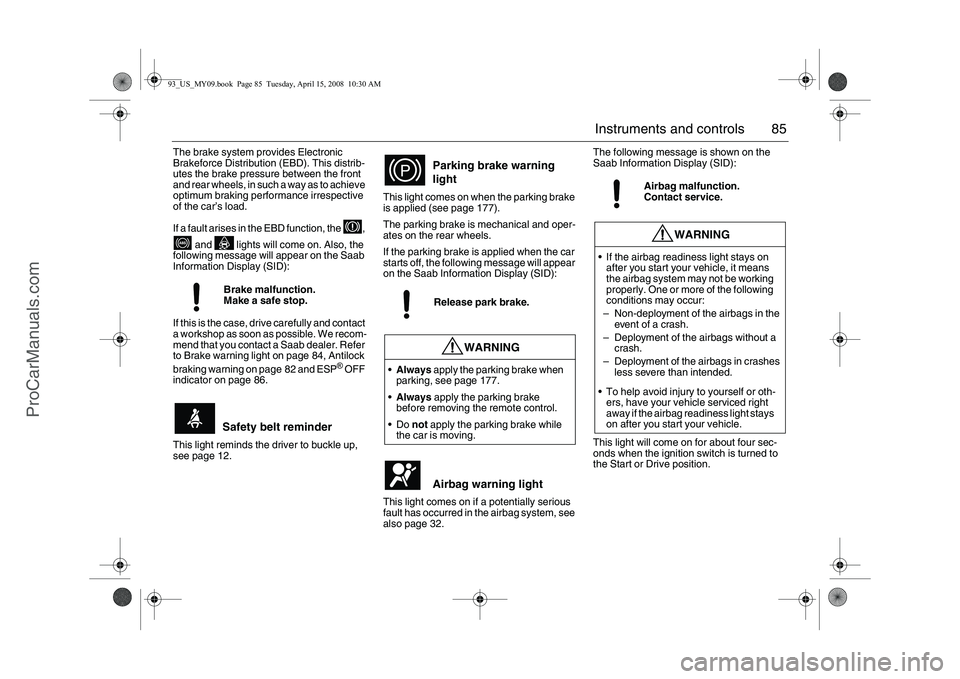
85 Instruments and controls
The brake system provides Electronic
Brakeforce Distribution (EBD). This distrib-
utes the brake pressure between the front
and rear wheels, in such a way as to achieve
optimum braking performance irrespective
of the car’s load.
If a fault arises in the EBD function, the ,
and lights will come on. Also, the
following message will appear on the Saab
Information Display (SID):
If this is the case, drive carefully and contact
a workshop as soon as possible. We recom-
mend that you contact a Saab dealer. Refer
to Brake warning light on page 84, Antilock
braking warning on page 82 and ESP
® OFF
indicator on page 86.
This light reminds the driver to buckle up,
see page 12.This light comes on when the parking brake
is applied (see page 177).
The parking brake is mechanical and oper-
ates on the rear wheels.
If the parking brake is applied when the car
starts off, the following message will appear
on the Saab Information Display (SID):
This light comes on if a potentially serious
fault has occurred in the airbag system, see
also page 32.The following message is shown on the
Saab Information Display (SID):
This light will come on for about four sec-
onds when the ignition switch is turned to
the Start or Drive position. Brake malfunction.
Make a safe stop.
Safety belt reminder
Parking brake warning
lightRelease park brake.
WARNING
Always apply the parking brake when
parking, see page 177.
Always apply the parking brake
before removing the remote control.
Do not apply the parking brake while
the car is moving.
Airbag warning light
Airbag malfunction.
Contact service.
WARNING
If the airbag readiness light stays on
after you start your vehicle, it means
the airbag system may not be working
properly. One or more of the following
conditions may occur:
– Non-deployment of the airbags in the
event of a crash.
– Deployment of the airbags without a
crash.
– Deployment of the airbags in crashes
less severe than intended.
To help avoid injury to yourself or oth-
ers, have your vehicle serviced right
away if the airbag readiness light stays
on after you start your vehicle.
93_US_MY09.book Page 85 Tuesday, April 15, 2008 10:30 AM
ProCarManuals.com